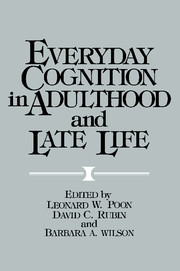Book contents
- Frontmatter
- Contents
- List of contributors
- Preface
- Part I Adult cognitive abilities in the laboratory and in real-life settings: Basic theoretical and methodological issues
- Part IA Systematic approaches to laboratory and real-world research
- Part IB Combining laboratory and real-world research
- Part II Cognition in adulthood and late life: Findings in real-life settings
- Part IIA Everyday cognitive abilities
- Part IIB Concomitant influences
- Part III Cognitive enhancement and aging: Clinical and educational applications
- Part IIIA Issues and perspectives
- Part IIIB Enhancement approaches
- Part IIIC Designing programs for cognitive rehabilitation
- 32 Designing memory-therapy programs
- 33 Management of memory problems in a hospital setting
- 34 Home-based cognitive rehabilitation with the elderly
- 35 Memory retraining: Everyday needs and future prospects
- Subject index
- Author index
33 - Management of memory problems in a hospital setting
Published online by Cambridge University Press: 05 October 2013
- Frontmatter
- Contents
- List of contributors
- Preface
- Part I Adult cognitive abilities in the laboratory and in real-life settings: Basic theoretical and methodological issues
- Part IA Systematic approaches to laboratory and real-world research
- Part IB Combining laboratory and real-world research
- Part II Cognition in adulthood and late life: Findings in real-life settings
- Part IIA Everyday cognitive abilities
- Part IIB Concomitant influences
- Part III Cognitive enhancement and aging: Clinical and educational applications
- Part IIIA Issues and perspectives
- Part IIIB Enhancement approaches
- Part IIIC Designing programs for cognitive rehabilitation
- 32 Designing memory-therapy programs
- 33 Management of memory problems in a hospital setting
- 34 Home-based cognitive rehabilitation with the elderly
- 35 Memory retraining: Everyday needs and future prospects
- Subject index
- Author index
Summary
Management techniques used in hospitals will vary according to the type of hospital ward and the clinical diagnoses of the patients. Different programs are used on acute general medical wards, rehabilitation wards, and long-stay wards. Different approaches are taken according to whether an impairment is one that is likely, to some extent, to show improvement (stroke or early head injury), to remain static (longer-term head injury), or to deteriorate (multiple sclerosis and dementia). Most of the previous literature has reported studies based on rehabilitation or geriatric wards. These will be considered in this chapter, but most emphasis will be placed on approaches that might be used on general medical wards, as there have been few published reports on the training of memory in this setting.
The studies considered are those that were designed for real-life memory problems, as opposed to investigations of the ability to learn experimental material. The former studies fall into two main categories. On geriatric or long-stay wards, the main approaches used are reality orientation, environmental modification, and reminiscence therapy. In a rehabilitation setting, training in specific memory strategies, such as visual imagery (Glasgow, Zeiss, Barrera, & Lewinsohn, 1977; Wilson 1981, 1982), PQRST (Glasgow et al., 1977), and first-letter cuing (Wilson, 1982), is more often used. These strategies may be carried out with individuals or in groups (Wilson & Moffat, 1984a).
- Type
- Chapter
- Information
- Everyday Cognition in Adulthood and Late Life , pp. 639 - 658Publisher: Cambridge University PressPrint publication year: 1989



